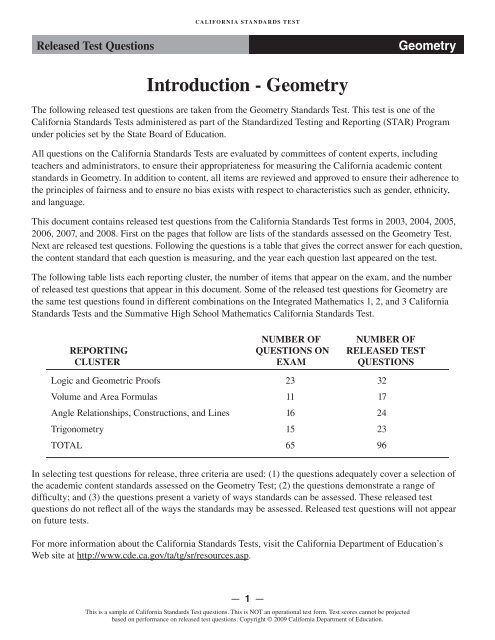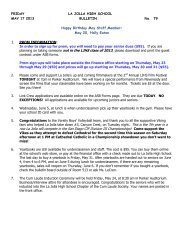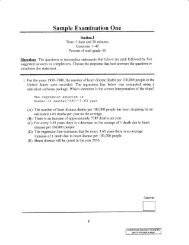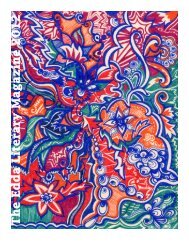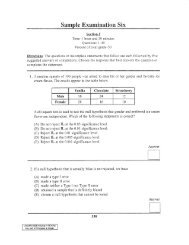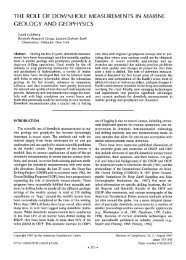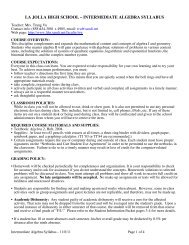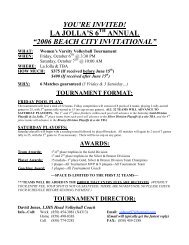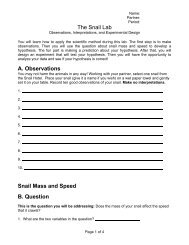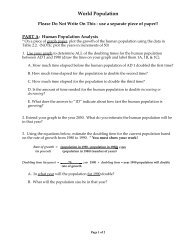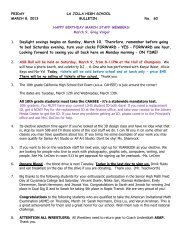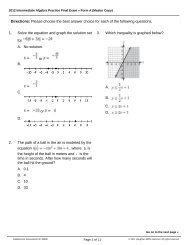CST 2008 Released Test Questions, Geometry - Standardized ...
CST 2008 Released Test Questions, Geometry - Standardized ...
CST 2008 Released Test Questions, Geometry - Standardized ...
You also want an ePaper? Increase the reach of your titles
YUMPU automatically turns print PDFs into web optimized ePapers that Google loves.
CA LI FOR N I A STA N DA R DS TE ST<br />
<strong>Released</strong> <strong>Test</strong> <strong>Questions</strong> <strong>Geometry</strong><br />
Introduction - <strong>Geometry</strong><br />
The following released test questions are taken from the <strong>Geometry</strong> Standards <strong>Test</strong>. This test is one of the<br />
California Standards <strong>Test</strong>s administered as part of the <strong>Standardized</strong> <strong>Test</strong>ing and Reporting (STAR) Program<br />
under policies set by the State Board of Education.<br />
All questions on the California Standards <strong>Test</strong>s are evaluated by committees of content experts, including<br />
teachers and administrators, to ensure their appropriateness for measuring the California academic content<br />
standards in <strong>Geometry</strong>. In addition to content, all items are reviewed and approved to ensure their adherence to<br />
the principles of fairness and to ensure no bias exists with respect to characteristics such as gender, ethnicity,<br />
and language.<br />
This document contains released test questions from the California Standards <strong>Test</strong> forms in 2003, 2004, 2005,<br />
2006, 2007, and <strong>2008</strong>. First on the pages that follow are lists of the standards assessed on the <strong>Geometry</strong> <strong>Test</strong>.<br />
Next are released test questions. Following the questions is a table that gives the correct answer for each question,<br />
the content standard that each question is measuring, and the year each question last appeared on the test.<br />
The following table lists each reporting cluster, the number of items that appear on the exam, and the number<br />
of released test questions that appear in this document. Some of the released test questions for <strong>Geometry</strong> are<br />
the same test questions found in different combinations on the Integrated Mathematics 1, 2, and 3 California<br />
Standards <strong>Test</strong>s and the Summative High School Mathematics California Standards <strong>Test</strong>.<br />
NUMBER OF NUMBER OF<br />
REPORTING QUESTIONS ON RELEASED TEST<br />
CLUSTER EXAM QUESTIONS<br />
Logic and Geometric Proofs 23 32<br />
Volume and Area Formulas 11 17<br />
Angle Relationships, Constructions, and Lines 16 24<br />
Trigonometry 15 23<br />
TOTAL 65 96<br />
In selecting test questions for release, three criteria are used: (1) the questions adequately cover a selection of<br />
the academic content standards assessed on the <strong>Geometry</strong> <strong>Test</strong>; (2) the questions demonstrate a range of<br />
difficulty; and (3) the questions present a variety of ways standards can be assessed. These released test<br />
questions do not reflect all of the ways the standards may be assessed. <strong>Released</strong> test questions will not appear<br />
on future tests.<br />
For more information about the California Standards <strong>Test</strong>s, visit the California Department of Education’s<br />
Web site at http://www.cde.ca.gov/ta/tg/sr/resources.asp.<br />
— 1 —<br />
This is a sample of California Standards <strong>Test</strong> questions. This is NOT an operational test form. <strong>Test</strong> scores cannot be projected<br />
based on performance on released test questions. Copyright © 2009 California Department of Education.
<strong>Geometry</strong><br />
CA LI FOR N I A STA N DA R DS TE ST<br />
THE LOGIC AND GEOMETRIC PROOFS REPORTING CLUSTER<br />
<strong>Released</strong> <strong>Test</strong> <strong>Questions</strong><br />
The following seven California content standards are included in the Logic and Geometric Proofs reporting<br />
cluster and are represented in this booklet by 32 test questions. These questions represent only some ways in<br />
which these standards may be assessed on the <strong>Geometry</strong> California Mathematics Standards <strong>Test</strong>.<br />
CALIFORNIA CONTENT STANDARDS IN THIS REPORTING CLUSTER<br />
<strong>Geometry</strong><br />
GE1.0* Students demonstrate understanding by identifying and giving examples of<br />
undefined terms, axioms, theorems, and inductive and deductive reasoning.<br />
GE2.0* Students write geometric proofs, including proofs by contradiction.<br />
GE3.0* Students construct and judge the validity of a logical argument and give<br />
counterexamples to disprove a statement.<br />
GE4.0* Students prove basic theorems involving congruence and similarity.<br />
GE5.0 Students prove that triangles are congruent or similar, and they are able to use<br />
the concept of corresponding parts of congruent triangles.<br />
GE6.0 Students know and are able to use the triangle inequality theorem.<br />
GE7.0* Students prove and use theorems involving the properties of parallel lines cut by<br />
a transversal, the properties of quadrilaterals, and the properties of circles.<br />
* Denotes key standards<br />
— 2 —<br />
This is a sample of California Standards <strong>Test</strong> questions. This is NOT an operational test form. <strong>Test</strong> scores cannot be projected<br />
based on performance on released test questions. Copyright © 2009 California Department of Education.
CA LI FOR N I A STA N DA R DS TE ST<br />
<strong>Released</strong> <strong>Test</strong> <strong>Questions</strong> <strong>Geometry</strong><br />
THE VOLUME AND AREA FORMULAS REPORTING CLUSTER<br />
The following four California content standards are included in the Volume and Area Formulas reporting<br />
cluster and are represented in this booklet by 17 test questions. These questions represent only some ways<br />
in which these standards may be assessed on the <strong>Geometry</strong> California Mathematics Standards <strong>Test</strong>.<br />
CALIFORNIA CONTENT STANDARDS IN THIS REPORTING CLUSTER<br />
<strong>Geometry</strong><br />
GE8.0* Students know, derive, and solve problems involving perimeter, circumference,<br />
area, volume, lateral area, and surface area of common geometric figures.<br />
GE9.0 Students compute the volumes and surface areas of prisms, pyramids, cylinders,<br />
cones, and spheres; and students commit to memory the formulas for prisms,<br />
pyramids, and cylinders.<br />
GE10.0* Students compute areas of polygons, including rectangles, scalene triangles,<br />
equilateral triangles, rhombi, parallelograms, and trapezoids.<br />
GE11.0 Students determine how changes in dimensions affect the perimeter, area, and<br />
volume of common geometric figures and solids.<br />
* Denotes key standards<br />
— 3 —<br />
This is a sample of California Standards <strong>Test</strong> questions. This is NOT an operational test form. <strong>Test</strong> scores cannot be projected<br />
based on performance on released test questions. Copyright © 2009 California Department of Education.
<strong>Geometry</strong><br />
CA LI FOR N I A STA N DA R DS TE ST<br />
<strong>Released</strong> <strong>Test</strong> <strong>Questions</strong><br />
THE ANGLE RELATIONSHIPS, CONSTRUCTIONS, AND LINES REPORTING<br />
CLUSTER<br />
The following six California content standards are included in the Angle Relationships, Constructions, and<br />
Lines reporting cluster and are represented in this booklet by 24 test questions. These questions represent only<br />
some ways in which these standards may be assessed on the <strong>Geometry</strong> California Mathematics Standards <strong>Test</strong>.<br />
CALIFORNIA CONTENT STANDARDS IN THIS REPORTING CLUSTER<br />
<strong>Geometry</strong><br />
GE12.0* Students find and use measures of sides and of interior and exterior angles of<br />
triangles and polygons to classify figures and solve problems.<br />
GE13.0 Students prove relationships between angles in polygons by using properties of<br />
complementary, supplementary, vertical, and exterior angles.<br />
GE14.0* Students prove the Pythagorean theorem.<br />
GE15.0 Students use the Pythagorean theorem to determine distance and find missing<br />
lengths of sides of right triangles.<br />
GE16.0* Students perform basic constructions with a straightedge and compass, such as<br />
angle bisectors, perpendicular bisectors, and the line parallel to a given line<br />
through a point off the line.<br />
GE17.0* Students prove theorems by using coordinate geometry, including the midpoint<br />
of a line segment, the distance formula, and various forms of equations of lines<br />
and circles.<br />
* Denotes key standards<br />
— 4 —<br />
This is a sample of California Standards <strong>Test</strong> questions. This is NOT an operational test form. <strong>Test</strong> scores cannot be projected<br />
based on performance on released test questions. Copyright © 2009 California Department of Education.
CA LI FOR N I A STA N DA R DS TE ST<br />
<strong>Released</strong> <strong>Test</strong> <strong>Questions</strong> <strong>Geometry</strong><br />
THE TRIGONOMETRY REPORTING CLUSTER<br />
The following five California content standards are included in the Trigonometry reporting cluster and are<br />
represented in this booklet by 23 test questions. These questions represent only some ways in which these<br />
standards may be assessed on the <strong>Geometry</strong> California Mathematics Standards <strong>Test</strong>.<br />
CALIFORNIA CONTENT STANDARDS IN THIS REPORTING CLUSTER<br />
<strong>Geometry</strong><br />
GE18.0* Students know the definitions of the basic trigonometric functions defined by the<br />
angles of a right triangle. They also know and are able to use elementary<br />
relationships between them. For example, tan(x) = sin(x)/cos(x), (sin (x)) 2 +<br />
(cos (x)) 2 = 1.<br />
GE19.0* Students use trigonometric functions to solve for an unknown length of a side of<br />
a right triangle, given an angle and a length of a side.<br />
GE20.0 Students know and are able to use angle and side relationships in problems with<br />
special right triangles, such as 30°, 60°, and 90° triangles and 45°, 45°, and 90°<br />
triangles.<br />
GE21.0* Students prove and solve problems regarding relationships among chords,<br />
secants, tangents, inscribed angles, and inscribed and circumscribed polygons<br />
of circles.<br />
GE22.0* Students know the effect of rigid motions on figures in the coordinate plane and<br />
space, including rotations, translations, and reflections.<br />
* Denotes key standards<br />
— 5 —<br />
This is a sample of California Standards <strong>Test</strong> questions. This is NOT an operational test form. <strong>Test</strong> scores cannot be projected<br />
based on performance on released test questions. Copyright © 2009 California Department of Education.
<strong>Geometry</strong><br />
1 Which of the following best describes deductive<br />
reasoning?<br />
<br />
A using logic to draw conclusions based on<br />
accepted statements<br />
B accepting the meaning of a term without<br />
definition<br />
C defining mathematical terms to correspond<br />
with physical objects<br />
D inferring a general truth by examining a<br />
number of specific examples<br />
2 In the diagram below, ∠1 ≅∠4.<br />
l<br />
m<br />
t<br />
3<br />
4<br />
1<br />
2<br />
CA LI FOR N I A STA N DA R DS TE ST<br />
CSG00185<br />
Which of the following conclusions does not<br />
have to be true?<br />
A ∠ 3 and ∠4 are supplementary angles.<br />
B Line l is parallel to line m.<br />
C ∠1 ≅∠3<br />
D ∠2 ≅∠3<br />
CSG10066<br />
— 6 —<br />
<br />
3 Consider the arguments below.<br />
<br />
<strong>Released</strong> <strong>Test</strong> <strong>Questions</strong><br />
I. Every multiple of 4 is even. 376 is a multiple<br />
of 4. Therefore, 376 is even.<br />
II. A number can be written as a repeating<br />
decimal if it is rational. Pi cannot be written<br />
as a repeating decimal. Therefore, pi is not<br />
rational.<br />
Which one(s), if any, use deductive reasoning?<br />
A I only<br />
B II only<br />
C both I and II<br />
D neither I nor II<br />
CSG00552<br />
4 Theorem: A triangle has at most one obtuse<br />
angle.<br />
Eduardo is proving the theorem above by<br />
contradiction. He began by assuming that in<br />
△ABC, ∠A and ∠B are both obtuse. Which<br />
theorem will Eduardo use to reach a<br />
contradiction?<br />
A If two angles of a triangle are equal, the sides<br />
opposite the angles are equal.<br />
B If two supplementary angles are equal, the<br />
angles each measure 90°.<br />
C The largest angle in a triangle is opposite the<br />
longest side.<br />
D The sum of the measures of the angles of a<br />
triangle is 180°.<br />
This is a sample of California Standards <strong>Test</strong> questions. This is NOT an operational test form. <strong>Test</strong> scores cannot be projected<br />
based on performance on released test questions. Copyright © 2009 California Department of Education.<br />
CSG00025
<strong>Released</strong> <strong>Test</strong> <strong>Questions</strong> <strong>Geometry</strong><br />
5 Use the proof to answer the question below.<br />
Given: AB≅BC; D is the midpoint of AC<br />
Prove: △ ABD≅△CBD<br />
B<br />
CA LI FOR N I A STA N DA R DS TE ST<br />
Statement Reason<br />
1. AB≅BC; D is the midpoint of AC 1. Given<br />
2. AD ≅CD 2. Definition of Midpoint<br />
3. BD ≅ BD 3. Reflexive Property<br />
4. △ ABD≅△CBD 4. ?<br />
What reason can be used to prove that the triangles are congruent?<br />
A AAS<br />
B ASA<br />
C SAS<br />
D SSS<br />
— 7 —<br />
This is a sample of California Standards <strong>Test</strong> questions. This is NOT an operational test form. <strong>Test</strong> scores cannot be projected<br />
based on performance on released test questions. Copyright © 2009 California Department of Education.<br />
A<br />
D<br />
C<br />
CSG10068
<strong>Geometry</strong><br />
<br />
6 In the figure below, AB > BC.<br />
C<br />
A<br />
If we assume that m∠ A = m∠ C,<br />
it follows that<br />
AB = BC. This contradicts the given statement<br />
that AB > BC. What conclusion can be drawn<br />
from this contradiction?<br />
A<br />
B<br />
C<br />
D<br />
m∠ A = m∠ B<br />
m∠A ≠m∠ B<br />
m∠ A = m∠ C<br />
m∠A ≠m∠ C<br />
CA LI FOR N I A STA N DA R DS TE ST<br />
B<br />
CSG00524<br />
— 8 —<br />
<strong>Released</strong> <strong>Test</strong> <strong>Questions</strong><br />
This is a sample of California Standards <strong>Test</strong> questions. This is NOT an operational test form. <strong>Test</strong> scores cannot be projected<br />
based on performance on released test questions. Copyright © 2009 California Department of Education.
C<br />
CA LI FOR N I A STA N DA R DS TE ST<br />
<strong>Released</strong> <strong>Test</strong> <strong>Questions</strong> <strong>Geometry</strong><br />
7 Use the proof to answer the question below.<br />
Given: ∠2 ≅∠3<br />
Prove: ∠1 ≅∠4<br />
Statement Reason<br />
1. ∠2 ≅∠3<br />
1. Given<br />
2. ∠1 ≅∠2; ∠ 3 ≅∠<br />
4 2. ?<br />
3. ∠1 ≅∠4<br />
3. Transitive Property<br />
What reason can be used to justify statement 2?<br />
A Complements of congruent angles are congruent.<br />
B Vertical angles are congruent.<br />
Supplements of congruent angles are congruent.<br />
D Corresponding angles are congruent.<br />
t<br />
4<br />
2<br />
3<br />
1<br />
— 9 —<br />
This is a sample of California Standards <strong>Test</strong> questions. This is NOT an operational test form. <strong>Test</strong> scores cannot be projected<br />
based on performance on released test questions. Copyright © 2009 California Department of Education.<br />
ℓ<br />
m<br />
CSG10069
<strong>Geometry</strong><br />
8 “Two lines in a plane always intersect in exactly<br />
one point.”<br />
Which of the following best describes a<br />
counterexample to the assertion above?<br />
A coplanar lines<br />
B parallel lines<br />
C perpendicular lines<br />
D intersecting lines<br />
CSG00320<br />
9 Which figure can serve as a counterexample to<br />
the conjecture below?<br />
If one pair of opposite sides of a<br />
quadrilateral is parallel, then the<br />
quadrilateral is a parallelogram.<br />
A rectangle<br />
B rhombus<br />
C square<br />
D trapezoid<br />
CSG10194<br />
10 Given: TRAP is an isosceles trapezoid with<br />
diagonals RP and TA. Which of the following<br />
must be true?<br />
A RP ⊥ TA<br />
B RP TA<br />
C RP ≅ TA<br />
D RP bisects TA<br />
CA LI FOR N I A STA N DA R DS TE ST<br />
CSG00260<br />
— 10 —<br />
<strong>Released</strong> <strong>Test</strong> <strong>Questions</strong><br />
11 A conditional statement is shown below.<br />
If a quadrilateral has perpendicular<br />
diagonals, then it is a rhombus.<br />
Which of the following is a counterexample to<br />
the statement above?<br />
A C<br />
B D<br />
This is a sample of California Standards <strong>Test</strong> questions. This is NOT an operational test form. <strong>Test</strong> scores cannot be projected<br />
based on performance on released test questions. Copyright © 2009 California Department of Education.<br />
CSG20216
CA LI FOR N I A STA N DA R DS TE ST<br />
<strong>Released</strong> <strong>Test</strong> <strong>Questions</strong> <strong>Geometry</strong><br />
12 Students in a class rewrote theorems in their <br />
own words. One student wrote the following<br />
statement.<br />
The area of a parallelogram is the<br />
product of any base (b) and any height (h).<br />
Which figure shows a counterexample to prove<br />
the statement false?<br />
A<br />
B<br />
C<br />
D<br />
b<br />
b<br />
h<br />
h<br />
h<br />
b<br />
h<br />
b<br />
CSG10102<br />
13 Which triangles must be similar?<br />
<br />
— 11 —<br />
A two obtuse triangles<br />
B two scalene triangles with congruent bases<br />
C two right triangles<br />
D two isosceles triangles with congruent<br />
vertex angles<br />
CSG00578<br />
14 Which of the following facts would be sufficient<br />
to prove that triangles ABC and DBE are<br />
similar?<br />
A<br />
D<br />
C E<br />
B<br />
A<br />
B<br />
C<br />
D<br />
CE and BE are congruent.<br />
∠ACE is a right angle.<br />
AC and DE are parallel.<br />
∠ A and ∠ B are congruent.<br />
This is a sample of California Standards <strong>Test</strong> questions. This is NOT an operational test form. <strong>Test</strong> scores cannot be projected<br />
based on performance on released test questions. Copyright © 2009 California Department of Education.<br />
CSG00544
<strong>Geometry</strong><br />
<br />
15 Parallelogram ABCD is shown below.<br />
<br />
D<br />
A B<br />
E<br />
Which pair of triangles can be established to<br />
be congruent to prove that ∠DAB ≅∠BCD ?<br />
A △ADC and △BCD<br />
B △AED and △BEC<br />
C △DAB and △BCD<br />
D △DEC and △BEA<br />
C<br />
CA LI FOR N I A STA N DA R DS TE ST<br />
CSG10146<br />
16 If △ABC and △XYZ are two triangles such<br />
AB BC<br />
that = , which of the following would<br />
XY YZ<br />
be sufficient to prove the triangles are similar?<br />
A ∠A ≅∠X<br />
B ∠B ≅∠Y<br />
C ∠C ≅∠Z<br />
D ∠X ≅∠Y<br />
CSG10218<br />
<br />
<br />
— 12 —<br />
<strong>Released</strong> <strong>Test</strong> <strong>Questions</strong><br />
17 In parallelogram FGHI, diagonals IG and FH<br />
are drawn and intersect at point M. Which of<br />
the following statements must be true?<br />
A<br />
B<br />
C<br />
D<br />
△FGI must be an obtuse triangle.<br />
△ HIG must be an acute triangle.<br />
△ FMG must be congruent to △HMG<br />
.<br />
△ GMH must be congruent to △IMF.<br />
18 Which of the following best describes the<br />
triangles shown below?<br />
60°<br />
30°<br />
8 8<br />
A both similar and congruent<br />
B similar but not congruent<br />
C congruent but not similar<br />
D neither similar nor congruent<br />
This is a sample of California Standards <strong>Test</strong> questions. This is NOT an operational test form. <strong>Test</strong> scores cannot be projected<br />
based on performance on released test questions. Copyright © 2009 California Department of Education.<br />
CSG00559<br />
CSG00478
CA LI FOR N I A STA N DA R DS TE ST<br />
<strong>Released</strong> <strong>Test</strong> <strong>Questions</strong> <strong>Geometry</strong><br />
19 Which of the following statements must be true<br />
if △GHI ∼△JKL?<br />
H K<br />
G I<br />
J L<br />
A The two triangles must be scalene.<br />
B The two triangles must have exactly one acute<br />
angle.<br />
C At least one of the sides of the two triangles<br />
must be parallel.<br />
D The corresponding sides of the two triangles<br />
must be proportional.<br />
CSG20074<br />
20 Which method listed below could not be used to<br />
prove that two triangles are congruent?<br />
A Prove all three sets of corresponding sides<br />
congruent.<br />
B Prove all three sets of corresponding angles<br />
congruent.<br />
C Prove that two sides and an included angle of<br />
one triangle are congruent to two sides and an<br />
included angle of the other triangle.<br />
D Prove that two angles and an included side of<br />
one triangle are congruent to two angles and<br />
an included side of the other triangle.<br />
CSG10151<br />
— 13 —<br />
21 In the figure below, AC ≅ DF and ∠ A ≅∠ D.<br />
A<br />
D<br />
C<br />
F<br />
Which additional information would be enough<br />
to prove that △ABC ≅△DEF?<br />
A AB ≅ DE<br />
B AB ≅ BC<br />
C BC ≅ EF<br />
D BC ≅ DE<br />
This is a sample of California Standards <strong>Test</strong> questions. This is NOT an operational test form. <strong>Test</strong> scores cannot be projected<br />
based on performance on released test questions. Copyright © 2009 California Department of Education.<br />
B<br />
E<br />
CSG00517
<strong>Geometry</strong><br />
<br />
22 Given: AB and CD intersect at point E;<br />
D<br />
A<br />
1<br />
∠1 ≅∠2<br />
3<br />
E<br />
4<br />
CA LI FOR N I A STA N DA R DS TE ST<br />
C<br />
2<br />
Which theorem or postulate can be used to<br />
prove △AED ∼△BEC ?<br />
A<br />
B<br />
C<br />
D<br />
AA<br />
SSS<br />
ASA<br />
SAS<br />
B<br />
CSG10074<br />
<br />
<br />
— 14 —<br />
<strong>Released</strong> <strong>Test</strong> <strong>Questions</strong><br />
23 Given: E is the midpoint of CD ; ∠C ≅∠D<br />
A<br />
C<br />
D<br />
E<br />
Which of the following statements must be true?<br />
A<br />
B<br />
C<br />
D<br />
∠A ≅∠D<br />
∠B ≅∠C<br />
CE ≅ BE<br />
AC ≅ BD<br />
B<br />
CSG10078<br />
24 In the figure below, n is a whole number. What<br />
is the smallest possible value for n?<br />
A 1<br />
B 7<br />
C 8<br />
D 14<br />
This is a sample of California Standards <strong>Test</strong> questions. This is NOT an operational test form. <strong>Test</strong> scores cannot be projected<br />
based on performance on released test questions. Copyright © 2009 California Department of Education.<br />
n<br />
15<br />
n<br />
CSG00295
CA LI FOR N I A STA N DAR DS T E ST<br />
<strong>Released</strong> <strong>Test</strong> <strong>Questions</strong> <strong>Geometry</strong><br />
25 Which of the following sets of numbers could<br />
represent the lengths of the sides of a triangle?<br />
A 2, 2, 5<br />
B 3, 3, 5<br />
C 4, 4, 8<br />
D 5, 5, 15<br />
CSG10041<br />
26 In the accompanying diagram, parallel lines l<br />
and m are cut by transversal t.<br />
t<br />
1<br />
Which statement about angles 1 and 2 must<br />
be true?<br />
A ∠1≅∠ 2.<br />
B ∠1isthecomplement of ∠2.<br />
C ∠1isthesupplement of ∠2.<br />
D ∠1and ∠2arerightangles.<br />
2<br />
l<br />
m<br />
CSG00579<br />
— 15 —<br />
27 What values of a and b make quadrilateral<br />
MNOP a parallelogram?<br />
3a – 2b<br />
A a= 1, b=<br />
5<br />
B a= 5, b=<br />
1<br />
C<br />
D<br />
N<br />
11 34<br />
a= , b=<br />
7 7<br />
34 11<br />
a= , b=<br />
7 7<br />
CSG10163<br />
28 Quadrilateral ABCD is a parallelogram. If<br />
adjacent angles are congruent, which statement<br />
must be true?<br />
21<br />
M 4a + b P<br />
A Quadrilateral ABCD is a square.<br />
B Quadrilateral ABCD is a rhombus.<br />
C Quadrilateral ABCD is a rectangle.<br />
D Quadrilateral ABCD is an isosceles<br />
trapezoid.<br />
This is a sample of California Standards <strong>Test</strong> questions. This is NOT an operational test form. <strong>Test</strong> scores cannot be projected<br />
based on performance on released test questions. Copyright © 2009 California Department of Education.<br />
13<br />
O<br />
CSG20048
<strong>Geometry</strong><br />
<br />
29 For the quadrilateral shown below, what is<br />
m∠ a + m∠ c?<br />
<br />
B 95 o<br />
a o<br />
A<br />
A 53°<br />
B 137°<br />
C 180°<br />
D 233°<br />
C<br />
c o<br />
32 o<br />
CA LI FOR N I A STA N DA R DS TE ST<br />
D<br />
CSG10162<br />
30 If ABCD is a parallelogram, what is the length<br />
of segment BD?<br />
7<br />
B C<br />
6<br />
E<br />
A D<br />
A 10<br />
B 11<br />
C 12<br />
D 14<br />
5<br />
CSG20236<br />
<br />
<strong>Released</strong> <strong>Test</strong> <strong>Questions</strong><br />
31 The diameter of a circle is 12 meters. If<br />
point P is in the same plane as the circle,<br />
and is 6 meters from the center of the circle,<br />
which best describes the location of point P?<br />
<br />
— 16 —<br />
A Point P must be on the circle.<br />
B Point P must be inside the circle.<br />
C Point P may be either outside the circle or<br />
on the circle.<br />
D Point P may be either inside the circle or<br />
on the circle.<br />
32 Given: p q;<br />
1<br />
m n;<br />
What is m∠ 2?<br />
A 15°<br />
B 75°<br />
C 90°<br />
D 105°<br />
m∠ 1 = 75°<br />
2<br />
m n<br />
This is a sample of California Standards <strong>Test</strong> questions. This is NOT an operational test form. <strong>Test</strong> scores cannot be projected<br />
based on performance on released test questions. Copyright © 2009 California Department of Education.<br />
q<br />
p<br />
CSG00532<br />
CSG20041
CA LI FOR N I A STA N DA R DS TE ST<br />
<strong>Released</strong> <strong>Test</strong> <strong>Questions</strong> <strong>Geometry</strong><br />
33 A right circular cone has radius 5 inches and <br />
height 8 inches.<br />
8 in.<br />
5 in.<br />
What is the lateral area of the cone? (Lateral<br />
area of cone = πrl, where l = slant height )<br />
A 40π sq in.<br />
B 445π sq in.<br />
C 5π 39 sq in.<br />
D 5π 89 sq in.<br />
l<br />
CSG00053<br />
34 Figure ABCD is a kite.<br />
<br />
— 17 —<br />
A<br />
10 cm<br />
10 cm<br />
6 cm<br />
B<br />
D<br />
8 cm<br />
8 cm<br />
17 cm<br />
15 cm<br />
17 cm<br />
What is the area of figure ABCD, in square<br />
centimeters?<br />
A 120<br />
B 154<br />
C 168<br />
D 336<br />
C<br />
CSG20157<br />
35 If a cylindrical barrel measures 22 inches in<br />
diameter, how many inches will it roll in<br />
8 revolutions along a smooth surface?<br />
A 121π in.<br />
B 168π in.<br />
C 176π in.<br />
D 228π in.<br />
This is a sample of California Standards <strong>Test</strong> questions. This is NOT an operational test form. <strong>Test</strong> scores cannot be projected<br />
based on performance on released test questions. Copyright © 2009 California Department of Education.<br />
CSG00564
<strong>Geometry</strong><br />
<br />
36 A sewing club is making a quilt consisting<br />
of 25 squares with each side of the square<br />
measuring 30 centimeters. If the quilt has<br />
five rows and five columns, what is the<br />
perimeter of the quilt?<br />
<br />
A 150 cm<br />
B 300 cm<br />
C 600 cm<br />
D 900 cm<br />
CA LI FOR N I A STA N DA R DS TE ST<br />
CSG20111<br />
37 The minute hand of a clock is 5 inches long.<br />
What is the area of the circle, in square inches,<br />
created as the hand sweeps an hour?<br />
A 10π<br />
B 20π<br />
C 25π<br />
D 100π<br />
CSG10223<br />
<br />
— 18 —<br />
<strong>Released</strong> <strong>Test</strong> <strong>Questions</strong><br />
38 The four sides of this figure will be folded up<br />
and taped to make an open box.<br />
5 centimeters<br />
What will be the volume of the box?<br />
A 50 cm 3<br />
B 75 cm 3<br />
C 100 cm 3<br />
D 125 cm 3<br />
This is a sample of California Standards <strong>Test</strong> questions. This is NOT an operational test form. <strong>Test</strong> scores cannot be projected<br />
based on performance on released test questions. Copyright © 2009 California Department of Education.<br />
CSG00299
CA LI FOR N I A STA N DAR DS T E ST<br />
<strong>Released</strong> <strong>Test</strong> <strong>Questions</strong> <strong>Geometry</strong><br />
39 A classroom globe has a diameter of 18 inches.<br />
Which of the following is the approximate<br />
surface area, in square inches, of the globe?<br />
(Surface Area = 4πr 2 )<br />
A 113.0<br />
B 226.1<br />
C 254.3<br />
D 1017.4<br />
CSG20238<br />
40 Vik is constructing a spherical model of Earth<br />
for his science fair project. His model has a<br />
radius of 24 inches. Since roughly 75% of<br />
Earth’s surface is covered by water, he wanted<br />
to paint 75% of his model blue to illustrate<br />
this fact. Approximately how many square<br />
inches on his model will be painted blue?<br />
( Surface Area = 4πr ) 2<br />
A 5426<br />
B 7235<br />
C 43,407<br />
D 57,877<br />
CSG10086<br />
— 19 —<br />
41 The rectangle shown below has length<br />
20 meters and width 10 meters.<br />
4 m<br />
4 m<br />
4 m 4 m<br />
4 m 4 m<br />
4 m<br />
4 m<br />
If four triangles are removed from the<br />
rectangle as shown, what will be the area of the<br />
remaining figure?<br />
A 136 m 2<br />
B 144 m 2<br />
C 168 m 2<br />
D 184 m 2<br />
42 If RSTW is a rhombus, what is the area of<br />
△WXT?<br />
S<br />
A 18 3<br />
B 36 3<br />
C 36<br />
D 48<br />
This is a sample of California Standards <strong>Test</strong> questions. This is NOT an operational test form. <strong>Test</strong> scores cannot be projected<br />
based on performance on released test questions. Copyright © 2009 California Department of Education.<br />
R<br />
X<br />
60 o<br />
T<br />
12<br />
W<br />
CSG00012<br />
CSG00227
<strong>Geometry</strong><br />
<br />
43 What is the area, in square units, of the<br />
trapezoid shown below?<br />
<br />
y<br />
(0, 5) (8, 5)<br />
0 (12, 0)<br />
A 37.5<br />
B 42.5<br />
C 50<br />
D 100<br />
44 The figure below is a square with four<br />
congruent parallelograms inside.<br />
5<br />
3<br />
CA LI FOR N I A STA N DA R DS TE ST<br />
12<br />
x<br />
CSG20226<br />
What is the area, in square units, of the shaded<br />
portion?<br />
A 60<br />
B 84<br />
C 114<br />
D 129<br />
CSG20225<br />
<br />
<br />
— 20 —<br />
<strong>Released</strong> <strong>Test</strong> <strong>Questions</strong><br />
45 What is the area, in square meters (m), of the<br />
trapezoid shown below?<br />
A<br />
B<br />
C<br />
D<br />
12 m<br />
5 m 5 m<br />
28<br />
36<br />
48<br />
72<br />
6 m<br />
CSG10047<br />
46 What is the area, in square inches (in.), of the<br />
triangle below?<br />
A<br />
B<br />
C<br />
D<br />
25<br />
25<br />
50<br />
50<br />
10 in.<br />
3<br />
3<br />
10 in.<br />
10 in.<br />
This is a sample of California Standards <strong>Test</strong> questions. This is NOT an operational test form. <strong>Test</strong> scores cannot be projected<br />
based on performance on released test questions. Copyright © 2009 California Department of Education.<br />
CSG10048
<strong>Released</strong> <strong>Test</strong> <strong>Questions</strong> <strong>Geometry</strong><br />
<br />
47 What is the area, in square centimeters,<br />
of rhombus RSTV if RT = 16 cm and<br />
SV = 12 cm?<br />
<br />
S T<br />
R V<br />
A 40<br />
B 48<br />
C 96<br />
D 192<br />
CA LI FOR N I A STA N DA R DS TE ST<br />
CSG20144<br />
48 The perimeters of two squares are in a ratio of<br />
4 to 9. What is the ratio between the areas of<br />
the two squares?<br />
A 2 to 3<br />
B 4 to 9<br />
C 16 to 27<br />
D 16 to 81<br />
CSG00013<br />
<br />
49 Lea made two candles in the shape of right<br />
rectangular prisms. The first candle is 15 cm<br />
high, 8 cm long, and 8 cm wide. The second<br />
candle is 5 cm higher but has the same length<br />
and width. How much additional wax was<br />
needed to make the taller candle?<br />
<br />
<br />
— 21 —<br />
A 320 cm 3<br />
B 640 cm 3<br />
C 960 cm 3<br />
D 1280 cm 3<br />
CSG20116<br />
50 Two angles of a triangle have measures of 55°<br />
and 65°. Which of the following could not be a<br />
measure of an exterior angle of the triangle?<br />
A 115°<br />
B 120°<br />
C 125°<br />
D 130°<br />
CSG00571<br />
51 The sum of the interior angles of a polygon is<br />
the same as the sum of its exterior angles. What<br />
type of polygon is it?<br />
A quadrilateral<br />
B hexagon<br />
C octagon<br />
D decagon<br />
This is a sample of California Standards <strong>Test</strong> questions. This is NOT an operational test form. <strong>Test</strong> scores cannot be projected<br />
based on performance on released test questions. Copyright © 2009 California Department of Education.<br />
CSG00305
<strong>Geometry</strong><br />
<br />
52 What is m∠ x ?<br />
B<br />
x<br />
60 25<br />
A C<br />
A 35°<br />
B 60°<br />
C 85°<br />
D 95°<br />
CA LI FOR N I A STA N DAR DS T E ST<br />
CSG<strong>2008</strong>6<br />
53 If the measure of an exterior angle of a regular<br />
polygon is 120°, how many sides does the<br />
polygon have?<br />
A 3<br />
B 4<br />
C 5<br />
D 6<br />
CSG20204<br />
54 In the figure below, AB CD.<br />
<br />
— 22 —<br />
A<br />
<strong>Released</strong> <strong>Test</strong> <strong>Questions</strong><br />
(x + 40)º (x – 40)º<br />
B C<br />
What is the value of x?<br />
A 40<br />
B 50<br />
C 80<br />
D 90<br />
D<br />
CSG00244<br />
55 The measures of the interior angles of a<br />
pentagon are 2x, 6x,4x−6,<br />
2x −16,<br />
and<br />
6x + 2.<br />
What is the measure, in degrees, of the<br />
largest angle?<br />
A 28<br />
B 106<br />
C 170<br />
D 174<br />
This is a sample of California Standards <strong>Test</strong> questions. This is NOT an operational test form. <strong>Test</strong> scores cannot be projected<br />
based on performance on released test questions. Copyright © 2009 California Department of Education.<br />
CSG10028
CA LI FOR N I A STA N DA R DS TE ST<br />
<strong>Released</strong> <strong>Test</strong> <strong>Questions</strong> <strong>Geometry</strong><br />
56 A regular polygon has 12 sides. What is the<br />
measure of each exterior angle?<br />
A<br />
B<br />
C<br />
D<br />
15°<br />
30°<br />
45°<br />
60°<br />
57 What is m∠1?<br />
1<br />
A<br />
B<br />
C<br />
D<br />
36<br />
34°<br />
56°<br />
64°<br />
92°<br />
o<br />
88<br />
o<br />
CSG00039<br />
CSG20179<br />
<br />
58 What is m∠ WZX ?<br />
<br />
— 23 —<br />
Y<br />
132º<br />
52º<br />
A 80°<br />
B 90°<br />
C 100°<br />
D 110°<br />
V<br />
Z<br />
W<br />
X<br />
CSG30022<br />
59 What is the measure of an exterior angle of a<br />
regular hexagon?<br />
A 30°<br />
B 60°<br />
C 120°<br />
D 180°<br />
This is a sample of California Standards <strong>Test</strong> questions. This is NOT an operational test form. <strong>Test</strong> scores cannot be projected<br />
based on performance on released test questions. Copyright © 2009 California Department of Education.<br />
CSG00570
Geometr y<br />
<br />
60 A diagram from a proof of the Pythagorean<br />
theorem is pictured below.<br />
a b<br />
c<br />
Which statement would not be used in the proof<br />
of the Pythagorean theorem?<br />
1<br />
A The area of a triangle equals ab.<br />
2<br />
B The four right triangles are congruent.<br />
C The area of the inner square is equal to half of<br />
the area of the larger square.<br />
D The area of the larger square is equal to the<br />
sum of the areas of the smaller square and the<br />
four congruent triangles.<br />
CA LI FOR N I A STA N DA R DS TE ST<br />
CSG10192<br />
— 24 —<br />
A 3<br />
B<br />
<strong>Released</strong> <strong>Test</strong> <strong>Questions</strong><br />
61 A right triangle’s hypotenuse has length 5. If<br />
one leg has length 2, what is the length of the<br />
other leg?<br />
21<br />
C 29<br />
D 7<br />
CSG00566<br />
62 A new pipeline is being constructed to re-route<br />
its oil flow around the exterior of a national<br />
wildlife preserve. The plan showing the old<br />
pipeline and the new route is shown below.<br />
60 miles<br />
NEW PIPELINE<br />
OLD PIPELINE<br />
32 miles<br />
About how many extra miles will the oil flow<br />
once the new route is established?<br />
A 24<br />
B 68<br />
C 92<br />
D 160<br />
This is a sample of California Standards <strong>Test</strong> questions. This is NOT an operational test form. <strong>Test</strong> scores cannot be projected<br />
based on performance on released test questions. Copyright © 2009 California Department of Education.<br />
CSG10016
<strong>Released</strong> <strong>Test</strong> <strong>Questions</strong> <strong>Geometry</strong><br />
<br />
63 What is the height of this rectangle?<br />
<br />
A<br />
B<br />
C<br />
D<br />
1 unit<br />
6 units<br />
15 units<br />
113 units<br />
8<br />
7<br />
?<br />
CA LI FOR N I A STA N DA R DS TE ST<br />
CSG00473<br />
64 Marsha is using a straightedge and compass to<br />
do the construction shown below.<br />
P<br />
Which best describes the construction Marsha<br />
is doing?<br />
A a line through P parallel to line l<br />
B a line through P intersecting line l<br />
C a line through P congruent to line l<br />
D a line through P perpendicular to line l<br />
l<br />
CSG00526<br />
<br />
— 25 —<br />
65 Given: angle A<br />
What is the first step in constructing the angle<br />
bisector of angle A?<br />
A<br />
A Draw ray AD.<br />
B<br />
C<br />
B Draw a line segment connecting points B<br />
and C.<br />
C From points B and C, draw equal arcs that<br />
intersect at D.<br />
D From point A, draw an arc that intersects the<br />
sides of the angle at points B and C.<br />
This is a sample of California Standards <strong>Test</strong> questions. This is NOT an operational test form. <strong>Test</strong> scores cannot be projected<br />
based on performance on released test questions. Copyright © 2009 California Department of Education.<br />
D<br />
CSG10131
<strong>Geometry</strong><br />
<br />
66 Scott is constructing a line perpendicular to<br />
line l from point P. Which of the following<br />
should be his first step?<br />
A<br />
B<br />
C<br />
D<br />
P<br />
P<br />
P<br />
P<br />
CA LI FOR N I A STA N DA R DS TE ST<br />
CSG00308<br />
l<br />
l<br />
l<br />
l<br />
— 26 —<br />
<strong>Released</strong> <strong>Test</strong> <strong>Questions</strong><br />
67 Which triangle can be constructed using the<br />
following steps?<br />
A<br />
B<br />
C<br />
D<br />
1. Put the tip of the compass on point A.<br />
2. Open the compass so that the pencil tip<br />
is on point B.<br />
3. Draw an arc above AB.<br />
4. Without changing the opening, put the<br />
metal tip on point B and draw an arc<br />
intersecting the first arc at point C.<br />
5. Draw AC and BC.<br />
right<br />
obtuse<br />
scalene<br />
equilateral<br />
C<br />
A B<br />
This is a sample of California Standards <strong>Test</strong> questions. This is NOT an operational test form. <strong>Test</strong> scores cannot be projected<br />
based on performance on released test questions. Copyright © 2009 California Department of Education.<br />
CSG10135
CA LI FOR N I A STA N DA R DS TE ST<br />
<strong>Released</strong> <strong>Test</strong> <strong>Questions</strong> <strong>Geometry</strong><br />
68 What geometric construction is shown in the <br />
diagram below?<br />
A<br />
A an angle bisector<br />
B a line parallel to a given line<br />
C an angle congruent to a given angle<br />
D a perpendicular bisector of a segment<br />
B<br />
CSG20029<br />
— 27 —<br />
69 The diagram shows △ABC.<br />
A<br />
y<br />
Which statement would prove that △ABC is a<br />
right triangle?<br />
A ( slope AB)( slope BC ) = 1<br />
B ( slope AB)( slope BC ) = − 1<br />
C distance from A to B = distance from B to C<br />
D distance from A to B = − (distance from<br />
B to C)<br />
This is a sample of California Standards <strong>Test</strong> questions. This is NOT an operational test form. <strong>Test</strong> scores cannot be projected<br />
based on performance on released test questions. Copyright © 2009 California Department of Education.<br />
B<br />
C<br />
CSG00475<br />
x
<strong>Geometry</strong><br />
CA LI FOR N I A STA N DA R DS TE ST<br />
70 Figure ABCO is a parallelogram. <br />
y<br />
A (a, b) B (a + c, b)<br />
O C (c, 0)<br />
What are the coordinates of the point of<br />
intersection of the diagonals?<br />
⎛a b⎞<br />
A ⎜ ,<br />
⎜<br />
⎟<br />
⎝2 2⎠ ⎟<br />
⎛c b⎞<br />
B ⎜ , ⎟<br />
⎜⎝2<br />
2⎠ ⎟<br />
⎛a+ c b⎞<br />
C ⎜ , ⎟<br />
⎜<br />
⎟<br />
⎝ 2 2⎠ ⎟<br />
⎛a+ c a+ b⎞<br />
D ⎜ , ⎟<br />
⎜<br />
⎟<br />
⎝ 2 2 ⎟⎠<br />
x<br />
CSG20101<br />
<strong>Released</strong> <strong>Test</strong> <strong>Questions</strong><br />
71 What type of triangle is formed by the points<br />
<br />
— 28 —<br />
A(4, 2),<br />
B(6,−1), and C(−1 , 3 )?<br />
A right<br />
B equilateral<br />
C isosceles<br />
D scalene<br />
72 The point (−3, 2)<br />
lies on a circle whose<br />
CSG10235<br />
( + ) 2 + + 2<br />
equation is x 3 ( y 1) = r 2 . Which of<br />
the following must be the radius of the circle?<br />
A 3<br />
B 10<br />
C 9<br />
D 10<br />
This is a sample of California Standards <strong>Test</strong> questions. This is NOT an operational test form. <strong>Test</strong> scores cannot be projected<br />
based on performance on released test questions. Copyright © 2009 California Department of Education.<br />
CSG30048
<strong>Released</strong> <strong>Test</strong> <strong>Questions</strong> <strong>Geometry</strong><br />
<br />
73 What is the length of line segment PQ shown<br />
below?<br />
A<br />
B<br />
C<br />
D<br />
P<br />
y<br />
9<br />
8<br />
7<br />
Q<br />
6 (8, 7)<br />
5<br />
4<br />
3<br />
2<br />
1 (0, 1)<br />
- 9 - 8 - 7 - 6 - 5 - 4 - 3 - 2 - 1 0 1 2 3 4 5 6 7 8 9<br />
- 1<br />
- 2<br />
- 3<br />
- 4<br />
- 5<br />
- 6<br />
- 7<br />
- 8<br />
- 9<br />
9 units<br />
10 units<br />
13 units<br />
14 units<br />
CA LI FOR N I A STA N DA R DS TE ST<br />
x<br />
CSG00540<br />
<br />
5<br />
74 In the figure below, if sin x = , what are<br />
cos x and tan x?<br />
13<br />
<br />
— 29 —<br />
x<br />
A cos = 12<br />
5<br />
x and tan x =<br />
13 12<br />
B cos = 12 12<br />
x and tan x =<br />
13 5<br />
C cos = 13<br />
5<br />
x and tan x =<br />
12 12<br />
D cos = 13 13<br />
x and tan x =<br />
12 5<br />
75 In the figure below, sin A = 07 . .<br />
C<br />
21<br />
B<br />
What is the length of AC?<br />
A 14.7<br />
B 21.7<br />
C 30<br />
D 32<br />
This is a sample of California Standards <strong>Test</strong> questions. This is NOT an operational test form. <strong>Test</strong> scores cannot be projected<br />
based on performance on released test questions. Copyright © 2009 California Department of Education.<br />
CSG00493<br />
CSG00432<br />
A
<strong>Geometry</strong><br />
76 Approximately how many feet tall is the<br />
streetlight?<br />
h<br />
A 12.8<br />
B 15.4<br />
C 16.8<br />
D 23.8<br />
20 ft<br />
sin 40°≈<br />
0.64<br />
cos40°≈<br />
0.77<br />
tan 40°≈ 0. 84<br />
CA LI FOR N I A STA N DAR DS T E ST<br />
40º<br />
CSG20047<br />
— 30 —<br />
<strong>Released</strong> <strong>Test</strong> <strong>Questions</strong><br />
77 Right triangle ABC is pictured below.<br />
This is a sample of California Standards <strong>Test</strong> questions. This is NOT an operational test form. <strong>Test</strong> scores cannot be projected<br />
based on performance on released test questions. Copyright © 2009 California Department of Education.<br />
A<br />
32º<br />
10.6<br />
8.2<br />
Which equation gives the correct value for BC?<br />
A<br />
B<br />
C<br />
D<br />
BC<br />
sin 32°=<br />
82 .<br />
BC<br />
cos 32°= 10.6<br />
82 .<br />
tan 58°=<br />
BC<br />
BC<br />
sin 58°= 10.6<br />
B<br />
C<br />
CSG10210
CA LI FOR N I A STA N DA R DS TE ST<br />
<strong>Released</strong> <strong>Test</strong> <strong>Questions</strong> <strong>Geometry</strong><br />
78 A 13-foot ladder is leaning against a brick wall. <br />
The top of the ladder touches the wall 12 feet (ft)<br />
above the ground. The bottom of the ladder is<br />
5 ft from the bottom of the wall. What is the<br />
sine of the angle formed by the ground and the<br />
base of the ladder?<br />
A<br />
B<br />
C<br />
D<br />
5<br />
12<br />
5<br />
13<br />
12<br />
13<br />
13<br />
5<br />
13 ft ladder<br />
5 ft<br />
wall<br />
12 ft<br />
CSG10141<br />
— 31 —<br />
79 In the accompanying diagram, m∠ A= 32° and<br />
AC = 10. Which equation could be used to find<br />
x in△ABC ?<br />
32°<br />
A C<br />
10<br />
A x =10 sin 32°<br />
B x =10 cos 32°<br />
C x =10 tan 32°<br />
10<br />
D x = cos32°<br />
This is a sample of California Standards <strong>Test</strong> questions. This is NOT an operational test form. <strong>Test</strong> scores cannot be projected<br />
based on performance on released test questions. Copyright © 2009 California Department of Education.<br />
B<br />
x<br />
CSG00555
<strong>Geometry</strong><br />
80 The diagram shows an 8-foot ladder leaning<br />
against a wall. The ladder makes a 53 angle<br />
with the wall. Which is closest to the distance<br />
up the wall the ladder reaches?<br />
A<br />
B<br />
C<br />
D<br />
3.2 ft<br />
4.8 ft<br />
6.4 ft<br />
9.6 ft<br />
8 ft<br />
sin 53° 0.80<br />
cos 53° 0.60<br />
tan 53° 1.33<br />
53°<br />
CA LI FOR N I A STA N DA R DS TE ST<br />
?<br />
CSG00342<br />
<br />
— 32 —<br />
81 Triangle JKL is shown below.<br />
J<br />
<strong>Released</strong> <strong>Test</strong> <strong>Questions</strong><br />
28<br />
K<br />
24 o<br />
Which equation should be used to find the<br />
length of JK ?<br />
JK<br />
A sin 24 °= 28<br />
28<br />
B sin 24 °= JK<br />
JK<br />
C cos 24 °= 28<br />
28<br />
D cos 24 °= JK<br />
This is a sample of California Standards <strong>Test</strong> questions. This is NOT an operational test form. <strong>Test</strong> scores cannot be projected<br />
based on performance on released test questions. Copyright © 2009 California Department of Education.<br />
L<br />
CSG20031
<strong>Released</strong> <strong>Test</strong> <strong>Questions</strong> <strong>Geometry</strong><br />
82 What is the approximate height, in feet, of the<br />
tree in the figure below?<br />
A<br />
B<br />
C<br />
D<br />
64.3<br />
76.6<br />
119.2<br />
130.5<br />
100 ft<br />
sin 50 °≈ 0 . 766<br />
50<br />
cos 50 °≈ 0 . 643<br />
tan 50 °≈ 1 . 192<br />
CA LI FOR N I A STA N DA R DS TE ST<br />
<br />
CSG20126<br />
— 33 —<br />
83 What is the approximate value of x in the<br />
triangle below?<br />
A<br />
B<br />
C<br />
D<br />
x<br />
3.4 units<br />
4.2 units<br />
4.9 units<br />
7.3 units<br />
6<br />
sin 35 °≈ 0 . 57<br />
cos 35 °≈ 0 . 82<br />
tan 35 °≈ 0 . 7<br />
This is a sample of California Standards <strong>Test</strong> questions. This is NOT an operational test form. <strong>Test</strong> scores cannot be projected<br />
based on performance on released test questions. Copyright © 2009 California Department of Education.<br />
35º<br />
CSG30029
<strong>Geometry</strong><br />
<br />
84 If a = 3 3 in the right triangle below, what is<br />
the value of b?<br />
A 9<br />
B 6 3<br />
C 12 3<br />
D 18<br />
b<br />
a<br />
c<br />
CA LI FOR N I A STA N DA R DS TE ST<br />
CSG10052<br />
— 34 —<br />
<br />
<strong>Released</strong> <strong>Test</strong> <strong>Questions</strong><br />
85 What is the value of x in the triangle below?<br />
A 5<br />
B<br />
5 2<br />
C 10 3<br />
D 20<br />
10<br />
B C<br />
x x<br />
This is a sample of California Standards <strong>Test</strong> questions. This is NOT an operational test form. <strong>Test</strong> scores cannot be projected<br />
based on performance on released test questions. Copyright © 2009 California Department of Education.<br />
A<br />
CSG10056
CA LI FOR N I A STA N DA R DS TE ST<br />
<strong>Released</strong> <strong>Test</strong> <strong>Questions</strong> <strong>Geometry</strong><br />
86 What is the value of x, in inches? <br />
30 o<br />
A 7 3<br />
B 14<br />
C 14 3<br />
D 21<br />
x<br />
7 in.<br />
CSG20099<br />
87 A square is circumscribed about a circle. What<br />
is the ratio of the area of the circle to the area<br />
of the square?<br />
A<br />
B<br />
C<br />
D<br />
1<br />
4<br />
1<br />
2<br />
2<br />
π<br />
π<br />
4<br />
CSG00585<br />
— 35 —<br />
88 In the circle below, AB and CD are chords<br />
intersecting at E.<br />
D<br />
A<br />
E<br />
B<br />
If AE = 5, BE = 12, and CE = 6, what is the<br />
length of DE?<br />
A 7<br />
B 9<br />
C 10<br />
D 13<br />
This is a sample of California Standards <strong>Test</strong> questions. This is NOT an operational test form. <strong>Test</strong> scores cannot be projected<br />
based on performance on released test questions. Copyright © 2009 California Department of Education.<br />
C<br />
CSG00022
<strong>Geometry</strong><br />
<br />
<br />
89 RB is tangent to a circle, whose center is A, at<br />
point B. BD is a diameter.<br />
R<br />
B<br />
25º<br />
What is m∠ CBR?<br />
A 50°<br />
B 65°<br />
C 90°<br />
D 130°<br />
A<br />
C<br />
CA LI FOR N I A STA N DA R DS TE ST<br />
D<br />
CSG20186<br />
<br />
— 36 —<br />
<strong>Released</strong> <strong>Test</strong> <strong>Questions</strong><br />
<br />
90 In the figure below, AB is tangent to circle O at<br />
point A, secant BD intersects circle O at points<br />
C and D, mA C = 70°,<br />
and mCD = 110°.<br />
O<br />
A<br />
D<br />
What is m∠ABC?<br />
A 20°<br />
B 40°<br />
C 55°<br />
D 70°<br />
This is a sample of California Standards <strong>Test</strong> questions. This is NOT an operational test form. <strong>Test</strong> scores cannot be projected<br />
based on performance on released test questions. Copyright © 2009 California Department of Education.<br />
70 o<br />
C<br />
110 o<br />
B<br />
CSG10257
CA LI FOR N I A STA N DA R DS TE ST<br />
<strong>Released</strong> <strong>Test</strong> <strong>Questions</strong> <strong>Geometry</strong><br />
91 In the circle shown below, the measure of<br />
PR = 140° and the measure of ∠ RPQ = 50 ° .<br />
140º<br />
R<br />
O<br />
50º<br />
?<br />
What is the measure of PQ<br />
A 50°<br />
B 60°<br />
C 70°<br />
D 120°<br />
P<br />
Q<br />
CSG10003<br />
— 37 —<br />
92 QS is a diameter of the circle below, and<br />
QS ⊥ PR.<br />
Q<br />
P R<br />
If mP QR = 106 °, what is mPS ?<br />
A 53°<br />
B 74°<br />
C 106°<br />
D 127°<br />
S<br />
CSG20187<br />
93 The vertices of △ABC are A(2, 1), B(3, 4), and<br />
C(1, 3). If △ABC is translated 1 unit down and<br />
3 units to the left to create △DEF, what are the<br />
coordinates of the vertices of △DEF?<br />
A D(0, 1), E(1, 2), F(1, 3)<br />
B D(0, –1), E(0, 3), F(–2, –2)<br />
C D(–2, 2), E(0, 3), F(–1, 0)<br />
D D(–1, 0), E(0, 3), F(–2, 2)<br />
This is a sample of California Standards <strong>Test</strong> questions. This is NOT an operational test form. <strong>Test</strong> scores cannot be projected<br />
based on performance on released test questions. Copyright © 2009 California Department of Education.<br />
CSG00317
<strong>Geometry</strong><br />
<br />
94 If triangle ABC is rotated 180 degrees about the<br />
origin, what are the coordinates of A′?<br />
y<br />
7<br />
6<br />
5<br />
4<br />
3<br />
-4<br />
-5<br />
-6<br />
-7<br />
B A<br />
2<br />
1<br />
C<br />
-7 -6 -5 -4 -3 -2 -1 0<br />
-1<br />
-2<br />
-3<br />
1 2 3 4 5 6 7<br />
A (−5, −4)<br />
( )<br />
( )<br />
B −5, 4<br />
C − 45 ,<br />
D ( −4, −5)<br />
CA LI FOR N I A STA N DA R DS TE ST<br />
x<br />
CSG10096<br />
<br />
— 38 —<br />
<strong>Released</strong> <strong>Test</strong> <strong>Questions</strong><br />
95 Trapezoid ABCD below is to be translated to<br />
trapezoid A′ BCD ′ ′ ′ by the following motion<br />
rule.<br />
( x, y)<br />
→( x + 3, y −4)<br />
D<br />
A<br />
y<br />
9<br />
8<br />
7<br />
6<br />
5<br />
4<br />
3<br />
2<br />
1<br />
-9 -8 -7 -6 -5 -4 -3 -2 -1 0<br />
-1<br />
-2<br />
-3<br />
-4<br />
-5<br />
-6<br />
-7<br />
-8<br />
-9<br />
B<br />
C<br />
1 2 3 4 5 6 7 8 9<br />
What will be the coordinates of vertex C′?<br />
A ( 1, −3)<br />
B ( 21 , )<br />
C ( 61 , )<br />
D ( 8, −3)<br />
This is a sample of California Standards <strong>Test</strong> questions. This is NOT an operational test form. <strong>Test</strong> scores cannot be projected<br />
based on performance on released test questions. Copyright © 2009 California Department of Education.<br />
x<br />
CSG10214
CA LI FOR N I A STA N DA R DS TE ST<br />
<strong>Released</strong> <strong>Test</strong> <strong>Questions</strong> <strong>Geometry</strong><br />
96 Which expression describes the translation of a<br />
point from ( −34 to 4, −1)? , ) (<br />
A 7 units left and 5 units up<br />
B 7 units right and 5 units up<br />
C 7 units left and 5 units down<br />
D 7 units right and 5 units down<br />
CSG20057<br />
— 39 —<br />
This is a sample of California Standards <strong>Test</strong> questions. This is NOT an operational test form. <strong>Test</strong> scores cannot be projected<br />
based on performance on released test questions. Copyright © 2009 California Department of Education.
<strong>Geometry</strong><br />
1<br />
2<br />
3<br />
4<br />
5<br />
6<br />
7<br />
8<br />
9<br />
10<br />
11<br />
12<br />
13<br />
14<br />
15<br />
16<br />
17<br />
18<br />
19<br />
20<br />
21<br />
22<br />
23<br />
24<br />
25<br />
26<br />
27<br />
28<br />
29<br />
30<br />
31<br />
32<br />
33<br />
34<br />
35<br />
CA LI FOR N I A STA N DA R DS TE ST<br />
Question Number Correct Answer Standard Year of Release<br />
A GE1.0 2004<br />
A GE1.0 2005<br />
C GE1.0 2007<br />
D GE2.0 2003<br />
D GE2.0 2004<br />
D GE2.0 2005<br />
B GE2.0 2007<br />
B GE3.0 2003<br />
D GE3.0 2004<br />
C GE3.0 2005<br />
A GE3.0 2006<br />
D GE3.0 <strong>2008</strong><br />
D GE4.0 2003<br />
C GE4.0 2004<br />
C GE4.0 2005<br />
B GE4.0 2005<br />
D GE4.0 2006<br />
A GE4.0 2007<br />
D GE4.0 2007<br />
B GE4.0 <strong>2008</strong><br />
A GE5.0 2003<br />
A GE5.0 2004<br />
D GE5.0 <strong>2008</strong><br />
C GE6.0 2003<br />
B GE6.0 2007<br />
C GE7.0 2003<br />
B GE7.0 2004<br />
C GE7.0 2005<br />
D GE7.0 2006<br />
A GE7.0 2006<br />
A GE7.0 <strong>2008</strong><br />
D GE7.0 <strong>2008</strong><br />
D GE8.0 2003<br />
C GE8.0 2005<br />
C GE8.0 2006<br />
— 40 —<br />
<strong>Released</strong> <strong>Test</strong> <strong>Questions</strong><br />
This is a sample of California Standards <strong>Test</strong> questions. This is NOT an operational test form. <strong>Test</strong> scores cannot be projected<br />
based on performance on released test questions. Copyright © 2009 California Department of Education.
CA LI FOR N I A STA N DA R DS TE ST<br />
<strong>Released</strong> <strong>Test</strong> <strong>Questions</strong> <strong>Geometry</strong><br />
Question Number Correct Answer Standard Year of Release<br />
36 C GE8.0 2007<br />
37 C GE8.0 <strong>2008</strong><br />
38 A GE9.0 2006<br />
39 D GE9.0 2006<br />
40 C GE9.0 <strong>2008</strong><br />
41 C GE10.0 2003<br />
42 A GE10.0 2004<br />
43 C GE10.0 2005<br />
44 B GE10.0 2006<br />
45 B GE10.0 2007<br />
46 B GE10.0 2007<br />
47 C GE10.0 <strong>2008</strong><br />
48 D GE11.0 2004<br />
49 A GE11.0 2005<br />
50 D GE12.0 2003<br />
51 A GE12.0 2003<br />
52 C GE12.0 2005<br />
53 A GE12.0 2005<br />
54 D GE12.0 2006<br />
55 C GE12.0 2007<br />
56 B GE12.0 <strong>2008</strong><br />
57 A GE13.0 2005<br />
58 A GE13.0 2006<br />
59 B GE13.0 2007<br />
60 C GE14.0 2004<br />
61 B GE15.0 2003<br />
62 A GE15.0 2004<br />
63 C GE15.0 <strong>2008</strong><br />
64 A GE16.0 2003<br />
65 D GE16.0 2004<br />
66 D GE16.0 2006<br />
67 D GE16.0 2007<br />
68 D GE16.0 <strong>2008</strong><br />
69 B GE17.0 2004<br />
70 C GE17.0 2005<br />
— 41 —<br />
This is a sample of California Standards <strong>Test</strong> questions. This is NOT an operational test form. <strong>Test</strong> scores cannot be projected<br />
based on performance on released test questions. Copyright © 2009 California Department of Education.
<strong>Geometry</strong><br />
CA LI FOR N I A STA N DA R DS TE ST<br />
Question Number Correct Answer Standard Year of Release<br />
71 D GE17.0 2006<br />
72 A GE17.0 2007<br />
73 B GE17.0 <strong>2008</strong><br />
74 A GE18.0 2003<br />
75 C GE18.0 2004<br />
76 C GE18.0 2006<br />
77 C GE18.0 2007<br />
78 C GE18.0 <strong>2008</strong><br />
79 C GE19.0 2003<br />
80 B GE19.0 2005<br />
81 A GE19.0 2006<br />
82 B GE19.0 2007<br />
83 B GE19.0 <strong>2008</strong><br />
84 A GE20.0 2004<br />
85 B GE20.0 2005<br />
86 A GE20.0 2007<br />
87 D GE21.0 2003<br />
88 C GE21.0 2004<br />
89 B GE21.0 2005<br />
90 C GE21.0 2006<br />
91 D GE21.0 2007<br />
92 D GE21.0 <strong>2008</strong><br />
93 D GE22.0 2003<br />
94 A GE22.0 2004<br />
95 D GE22.0 2006<br />
96 D GE22.0 <strong>2008</strong><br />
— 42 —<br />
<strong>Released</strong> <strong>Test</strong> <strong>Questions</strong><br />
This is a sample of California Standards <strong>Test</strong> questions. This is NOT an operational test form. <strong>Test</strong> scores cannot be projected<br />
based on performance on released test questions. Copyright © 2009 California Department of Education.


